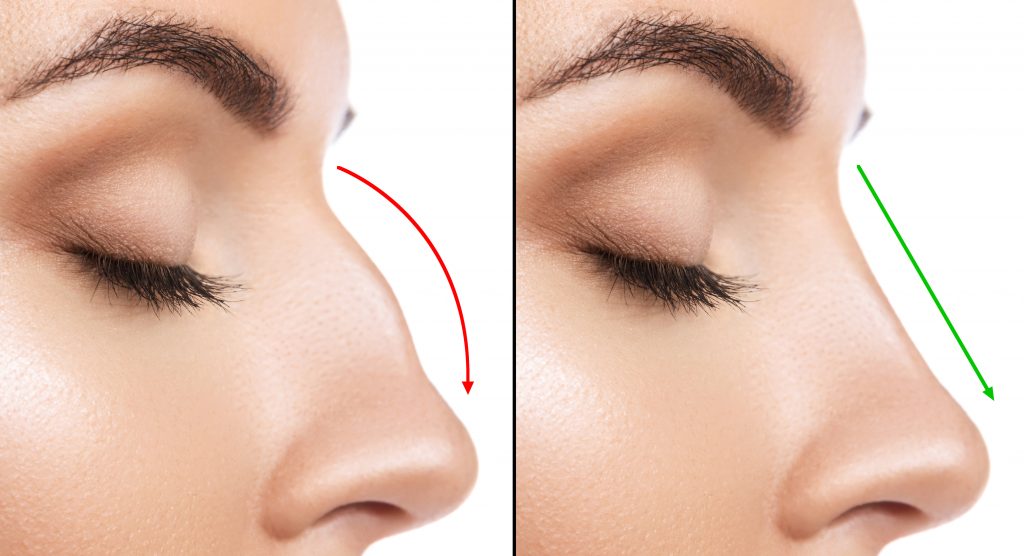
Dr. Menachof, MD, FACS has performed thousands of facial plastic surgery procedures in over 20 years of experience. He has been recognized as a Fellow by multiple academies, named one of America’s Top Facial Plastic Surgeons continually since 2003 and is featured in multiple national publications.
Many patients consult surgeons to remove or lessen the bump on the ridge of their nose – the dorsal hump. This bump can have a range of prominence and can be the result of multiple causes. No matter the origin or size, the dorsal hump can be reduced with both surgical and nonsurgical solutions.
What is a Dorsal Hump?
A dorsal hump consists of a mix of bone and cartilage. When patients view their facial profile, the dorsal hump begins at the top part of their nose near the eyes, and ends before the nasal tip. The majority of patients with a dorsal hump desire a flatter, smoother nasal bridge.
What Causes a Dorsal Hump Nose?
There are multiple causes of dorsal humps – genetics, impact or previous injury. The majority of dorsal humps are inherited, which is why it is important to wait until the nose is fully developed before considering a dorsal hump reduction.
Impact to the nose can cause a dorsal hump, even if no bones were broken. The upper lateral cartilage and septum can separate from the bone, and cave in, making the nasal bone appear to stick out. After a nasal trauma, if there is a pressure on the bump, it is more likely swelling than a permanent dorsal hump. After impact, be sure to ice the nose and minimize direct contact. If your nasal concerns persist, contact a certified facial plastic surgeon – they will be able to assess your bone and cartilage damage to see if it is permanent.
Dorsal Hump Reduction
The goal of this procedure is to make the dorsal aesthetic lines smooth and in proportion with the rest of the patient’s nose and face.
Small or large dorsal humps can be reduced using closed rhinoplasty techniques. Surgeons will assess the size of the hump, the patient’s desired nasal structure, the presence of cartilage and bone and the length of the patient’s nasal bones. In order to reduce a dorsal hump, it’s important to identify the cause of the hump because in some cases, nonsurgical techniques can fix the nose.

Dorsal Hump Reduction Before and After
If the dorsal hump is small and the patient has a supportive bridge area, then filing down the hump may be the solution to reducing the dorsal hump. If the hump is larger and the nasal bones are shorter, upper lateral cartilages can lose support, which can be avoided with the placement of spreader grafts during surgery. If the hump is reduced and there is an opening between the nasal bones, then lateral osteotomies (fractures of the nasal bones) may be performed to restore a normal appearance of the nasal bridge.
Your surgeon will be clear with you before the procedure regarding your potential need for osteotomies. Osteotomies may sound intimidating, but they are small, controlled, curved fractures of the nasal bones. The surgeon will determine if the bones will need to be osteotomized or not during the procedure – if the nasal bones are separated during the dorsal hump reduction, delicate osteotomies may be necessary. If the nasal bones are fractured during the procedure, there may be increased bruising and swelling. Whether osteotomies are performed or not, the pain should be mild and the patient should look presentable after ten days following the surgery.
After a dorsal hump removal, there may be excessive swelling where the hump was removed. This should disappear over the first three to four months following the surgery, depending on how much work was done on the dorsal hump. However, after a dorsal hump reduction, there is typically minimal bruising and swelling.
This procedure typically takes an hour and a half and ranges in pricing. Each individual has different nasal needs, but the average dorsal hump removal cost is $4,500. Consult a facial plastic surgeon to assess your nose in person. They will provide a customized treatment to help you accomplish your desired nasal structure.
Dorsal Hump Removal Without Surgery
Nonsurgical procedures are not permanent solutions for dorsal humps. Fillers can camouflage small dorsal bumps, but will not permanently fix them.
Fillers are injected into the depression above the nose hump to make the bridge more of a straight line. For this reason, if the dorsal hump is large, an injectable filler will not be the right solution.
Fillers need to be repeated at frequent intervals, as they last six months to a couple of years. This dorsal hump removal without surgery takes less than 10 minutes, and requires no downtime afterwards.
Consult an experienced surgeon about your nasal needs. Make sure that you understand the dorsal hump procedure to ensure that the surgery plan will lead you towards your expected results.




